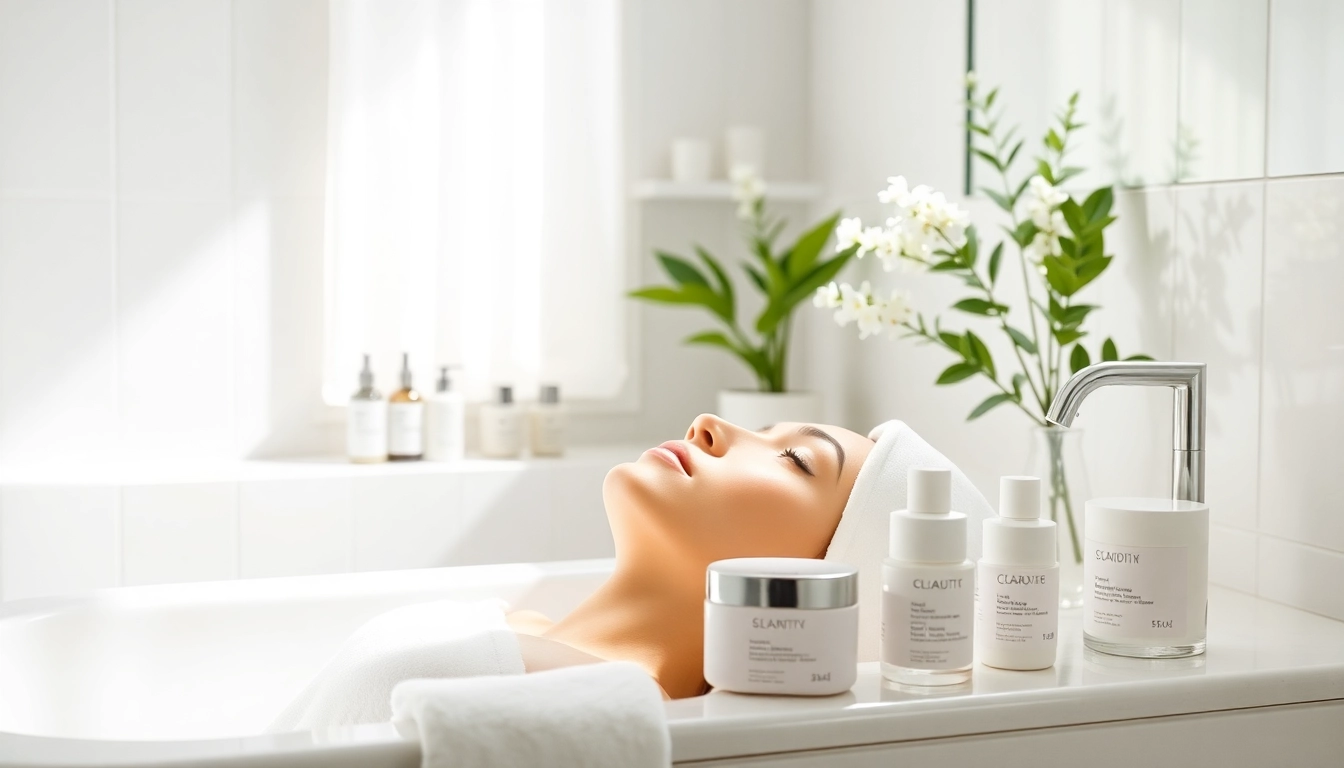Understanding Deep Cleansing and Its Benefits
What is Deep Cleansing?
Deep cleansing is a skincare technique that goes beyond the everyday cleansing routine. It involves a thorough removal of dirt, oil, makeup, and other impurities from the skin pores. Unlike standard cleansers that may only remove surface-level debris, deep cleansing targets the buildup that can lead to clogged pores, acne, and uneven skin tone. This process can incorporate a variety of products and techniques, adapting to individual skin needs.
With advancements in skincare research, deep cleansing has evolved to include a plethora of specialized products designed for various skin types, ensuring that everyone can benefit from a refreshed and radiant complexion. For more insights on effective techniques and products, you may refer to this guide on deep cleansing.
Key Benefits for Different Skin Types
Understanding the benefits of deep cleansing is essential in developing an effective skincare routine. Here are some of the primary advantages based on different skin types:
- Oily Skin: Deep cleansing helps remove excess sebum and prevents the formation of acne and blackheads. Using oil-free or gel-based cleansers with salicylic acid can minimize shine while effectively targeting clogged pores.
- Dry Skin: For dry skin, products that hydrate while cleansing, like cream cleansers containing natural oils and humectants, can help to remove impurities without stripping essential moisture. Deep cleansing can enhance the absorption of moisturizers applied afterward.
- Combination Skin: This skin type benefits from a balanced approach. Using a dual-action cleanser that removes excess oil from the T-zone while hydrating dry areas can ensure a thorough clean without exacerbating dryness or oiliness.
- Sensitive Skin: Gentle, hypoallergenic formulas are key for sensitive skin. Deep cleansing with products designed to soothe, such as those with chamomile or aloe, can help cleanse while minimizing irritation.
When to Incorporate Deep Cleansing into Your Routine
Integrating deep cleansing into your skincare routine calls for timing and consistency. Generally, deep cleansing should be performed 1-2 times a week, depending on individual skin needs. Here are some considerations:
- After a busy week or heavy makeup days, a deep cleanse can reset your skin.
- Seasonal transitions, when the skin may react differently to environmental changes, may warrant a more frequent cleansing routine.
- Prepping skin before a special event can lead to a fresh, clear complexion.
Choosing the Right Deep Cleansing Products
Types of Cleansers: Gel, Cream, and Oils
Choosing the right type of cleanser is crucial for effective deep cleansing. Here’s a breakdown of common cleanser types:
- Gel Cleansers: Great for oily and acne-prone skin, gel cleansers are formulated to dissolve excess oil and debris, often containing exfoliating agents to help deep cleanse without the need for harsh scrubbing.
- Cream Cleansers: Ideal for dry and sensitive skin types, these cleansers are more hydrating and maintain moisture while effectively cleansing the skin. They create a nourishing barrier that protects the skin post-cleanse.
- Oil Cleansers: Efficacious for all skin types, oil cleansers work by dissolving makeup and excess oils, providing a thorough but gentle cleanse. They are often recommended for double cleansing methods, allowing for deeper penetration and removal of impurities.
Essential Ingredients for Optimal Results
The effectiveness of a deep cleansing product also hinges on its formulation. Key ingredients to look for include:
- Salicylic Acid: Particularly beneficial for acne-prone skin, it penetrates pores to dissolve the debris that causes breakouts.
- Glycolic Acid: A member of the alpha hydroxy acid (AHA) family, it aids in exfoliation, removing dead skin cells and promoting cell turnover.
- Charcoal: Highly absorbent, charcoal is superb at drawing impurities from the skin, making it an excellent choice for deep cleansing masks and washes.
- Tea Tree Oil: Known for its antibacterial properties, tea tree oil is effective for treating and preventing acne during deep cleansing routines.
How to Read Product Labels Effectively
Being able to read product labels effectively can make a significant difference in choosing the right deep cleansing products. Here are some tips:
- Start by identifying the active ingredients, as they are the ones that deliver the promised benefits.
- Check for potential allergens or irritants such as fragrances, which can be problematic for sensitive skin.
- Look for products labeled “non-comedogenic” if you have oily or acne-prone skin, ensuring that they won’t block pores.
Step-by-Step Guide to Deep Cleansing
Preparing Your Skin for Cleansing
Before diving into the cleansing process, it’s crucial to prepare your skin properly. Start with the following steps:
- Remove Makeup: Use a makeup remover or micellar water to take off any makeup. This step ensures that your cleanser can effectively target dirt and oil.
- Warm Water Rinse: Splash your face with warm water to open up the pores, providing a better environment for the cleanser to act effectively.
Techniques for Effective Removal of Impurities
Once the skin is prepped, follow these techniques to ensure a comprehensive cleansing:
- Apply Cleanser: Use your fingertips to gently apply the cleanser in circular motions, focusing on areas prone to buildup such as the T-zone.
- Allow for Absorption: Let the cleanser sit on your skin for a few minutes to maximize its effect, especially for products containing active ingredients.
- Rinse Thoroughly: Use lukewarm water to rinse off the cleanser, ensuring no product is left behind as residue can lead to irritation.
Aftercare: Keeping Your Skin Healthy
After deep cleansing, care for your skin with these important steps:
- Moisturize: Apply a hydrating moisturizer to lock in moisture that may have been lost during the cleansing process.
- Apply Serums or Treatments: Layer on specific treatments that cater to your skin types, such as serums with antioxidants or acne-fighting ingredients, to maintain the skin’s clarity and health.
- Use Sunscreen: If deep cleansing during the daytime, ensure to apply sunscreen to protect your skin from UV damage.
Common Mistakes in Deep Cleansing
Over-cleansing: The Risks to Your Skin
While deep cleansing can be beneficial, overdoing it can harm your skin. Common signs of over-cleansing include dryness, irritation, and compromised skin barrier function. Limit the frequency to 1-2 times per week, adjusting based on individual skin response.
Ignoring Skin Type Variations
Choosing products not suited for your specific skin type may result in aggravation rather than improvement. It’s imperative to select cleansers that match your skin’s needs to avoid issues such as breakouts or excessive dryness.
Skincare Routine: Balancing Cleansing and Moisturizing
Mistakenly neglecting post-cleansing care can hinder results. Following deep cleansing, always ensure you apply suitable moisturization and treatment products to support skin recovery and hydration.
Advanced Deep Cleansing Techniques to Consider
Facial Steaming for Enhanced Purification
Facial steaming is an excellent method to enhance your deep cleansing routine. It involves exposing your face to steam, which helps to open up pores and allow for deeper penetration of cleansers. This technique can elevate the effectiveness of your cleansing products:
- Steaming can be done at home using a facial steamer or a bowl of hot water.
- After steaming, continue with your usual cleansing routine for maximum benefits.
Exfoliation: How It Complements Deep Cleansing
Exfoliation is a vital component of maintaining clear skin. Incorporating exfoliating steps within your deep cleansing routine can help remove dead skin cells and improve overall texture:
- Physical Exfoliants: These include scrubs with small particles that physically rub off dead skin cells. Use gently to avoid skin damage.
- Chemical Exfoliants: These utilize AHAs or BHAs that dissolve dead skin and impurities. They offer a gentler alternative to physical scrubs.
Professional Treatments: When to Seek Expert Help
For persistent skin issues or if you want the ultimate deep cleansing experience, professional treatments like facials or chemical peels can provide impressive results. These treatments are tailored by skincare professionals to meet the unique needs of your skin type and condition:
- Consulting with a dermatologist can help determine which treatments may work best for your skin concerns.
- Regular professional treatments can complement your at-home deep cleansing routines and provide more substantial results.



